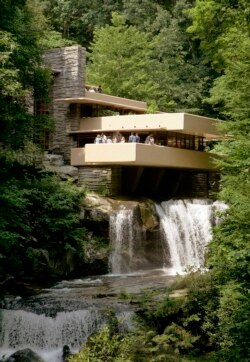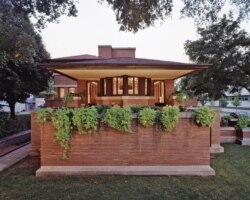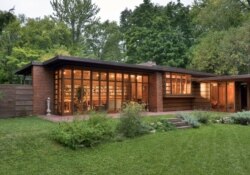He is arguably America’s best known architect — in part because he was a shameless self-promoter — but Frank Lloyd Wright also possessed the talent and success to back up his boasts. And now eight of his designs are being recognized on a global scale.
“The 20th century Architecture of Frank Lloyd Wright” was recently added to the list of UNESCO World Heritage Sites. The designation is given to places that are deemed to have “outstanding universal value to humanity.” It's rare for an architect to be designated by name on the list.
“I think Wright's work was unique because he was unique,” says architectural historian William Richards. “Wright was calculating about his persona and he was an iconoclast who, I think, wore his uniqueness as a badge of honor.”
The eight Wright structures, which include private homes, a church and a world-famous museum, are some of the only 20th-century pieces of architecture in the world to receive the honor.
“They're all fairly modest in scale,” says Richards of Wright’s works, “but they had an absolutely outsized influence on generations of architects who thought about how we live in our homes, how we worship in our sanctuaries, how we use public space, and even how we engage artworks.”
UNESCO says the buildings reflect the “organic architecture” developed by Wright, including an open plan, a blurring of the boundaries between the inside and outside of the house, and the unprecedented use of materials such as steel and concrete.
Wright didn’t pioneer the open floor plan coveted by today’s homeowners but his embrace of the concept helped popularize the design element.
Although Wright’s designs are up to a century old, they retain an air of modernity. One of the structures designated by UNESCO is the Robie House in Chicago. Constructed in 1910, its emphasis of the horizontal over the vertical recalls the flat American plains, and the cantilevered roof connects the interior to the outdoors.
“I’m always struck when I see the Robie House in Chicago,” says architect Susan Piedmont-Palladino, director of Virginia Tech's Washington Alexandria Architecture Center. “When you go visit, it looks more modern than many of the buildings around it and it's 110 years old ... It wouldn't look odd with a Tesla in front of it.”
Another Wright building on the list is the Guggenheim Museum in New York City. Completed in 1959, its circular, organic design still feels innovative, even though the building is 60 years old.
The same is true of other Wright buildings on the list, all of which were built between 1906 and 1969.
They include Unity Temple in Oak Park, Illinois; Taliesin in Spring Green, Wisconsin; Hollyhock House in Los Angeles, California;< Fallingwater in Mill Run, Pennsylvania; the Herbert and Katherine Jacobs House in Madison, Wisconsin; and Taliesin West in Scottsdale, Arizona.
“What he gave American architecture, I think, is a series of designs that are very clearly borne out of deep thinking, a concern for the landscape, and acknowledgement of the landscape, a design philosophy ... something that could be defined as ‘American,’” Richards says.
“I think that's probably his biggest statement about architecture, which is that American architecture can't possibly reference somebody else's era, some other country's heritage. It's got to be expressly its own.”
In his 70-year career, Wright designed 1,114 architectural works, 532 of which were actually built by the time he died in 1959. The American Institute of Architects considers Wright the “greatest American architect of all time.”
Wright also changed the course of American architecture.
“Not because he gave architects something that they could repeat over and over again,” Richards says. “He gave them the OK really to pursue individuality whenever possible ... he didn’t give them a formula to replicate his work, but he gave him kind of an invitation to be themselves.”
The only other U.S. works of architecture on the list of World Heritage Sites list are Independence Hall in Philadelphia, Pennsylvania, and Monticello, Thomas Jefferson’s home in Charlottesville, Virginia.




![Frank Lloyd Wright wrote, "[Taliesin] was set so sun came through the openings into every room sometime during the day. Walls opened everywhere to views as windows swung out above the tree-tops..." (Courtesy Frank Lloyd Wright Foundation/Andrew Pielage)](https://gdb.voanews.com/3d87be98-8570-4bc4-9983-05f984f3b5f0_w250_r1_s.jpg)







